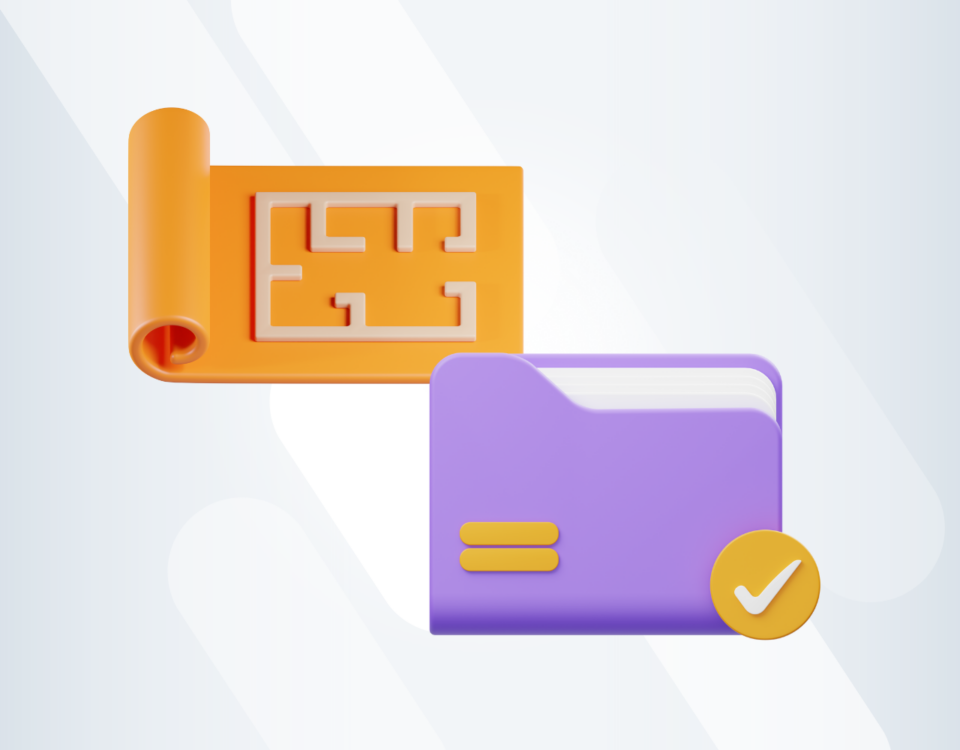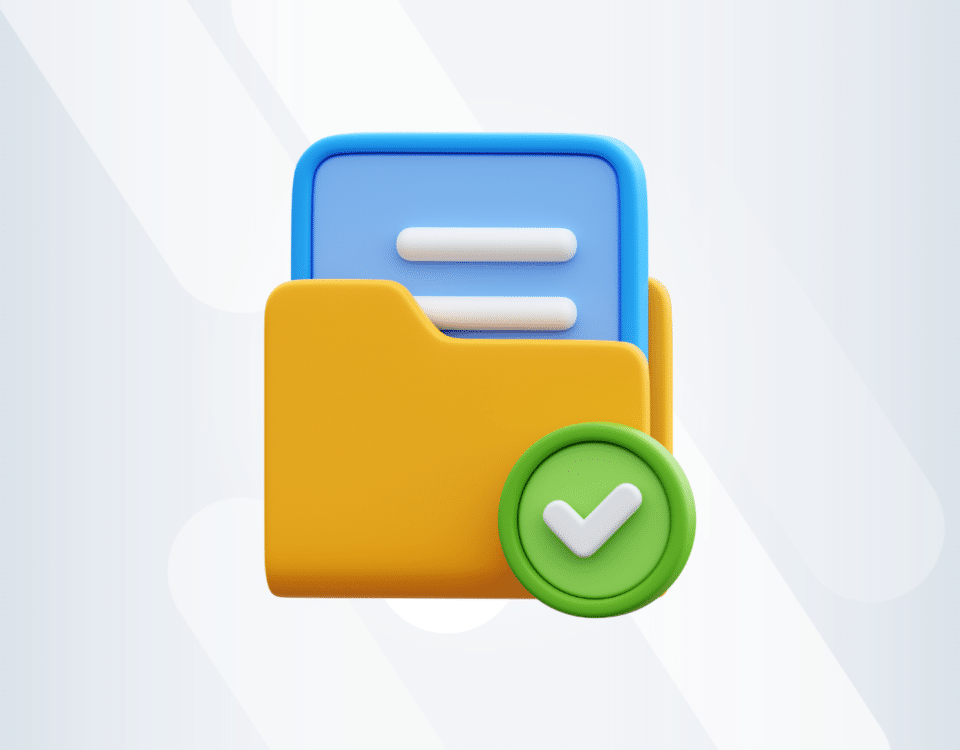Construction Tips, News & Best Practices
UK Construction Cost Codes 101
The Essential Guide (2023)

Danny Mitchell
Head of Content Marketing
Everyone speaks the same language when using construction cost codes. They’re the rosetta stone of our industry.
They help you track and manage the costs of construction. It’s easy for all players to understand what’s being spent on what.
Here’s almost everything you need to know about construction cost codes.
What is a cost coding structure?
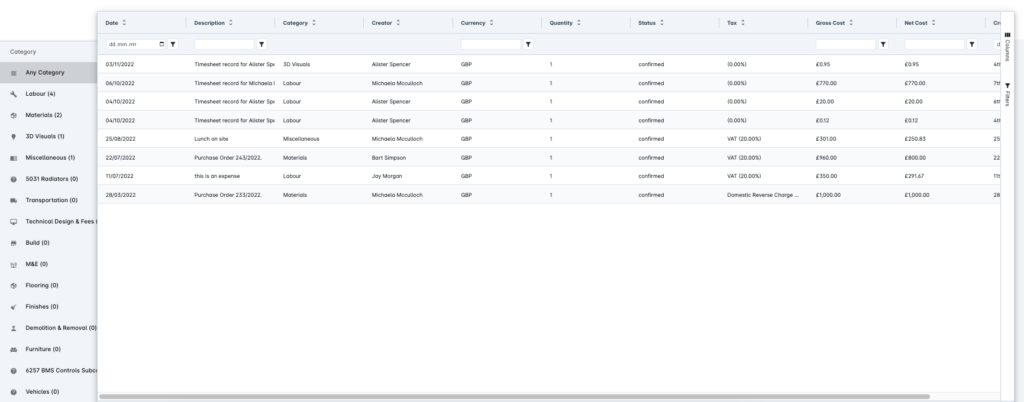
Construction cost codes are a set of standard codes used for cataloguing, tracking, reporting, and managing expenses related to a construction project.
These codes allow you to get complete budgeting visibility for each project you handle.
These codes are crucial for tracking and evaluating project expenses, increasing the accuracy of task costing, and streamlining interactions across various departments and organisations.
By assigning a code to each cost item, you can quickly filter through the expenses and determine what needs to be prioritised, cut, or adjusted.
Content you might like: are you looking for accounting software to handle construction finances?
What do you find in a cost coding structure?
In cost coding structures, you will find elements like:
Project ID/Job number: this represents the job that connects to the cost code and cost.
Cost code: this is a code that relates to the specific cost item or activity. They will vary depending on how you organise your cost codes, with the three main ways being:
- Work Breakdown Structures (WBS): sort the cost codes by breaking the project into smaller, manageable parts, each with its own cost code.
It’s a hierarchical approach that helps you track and control costs and progress together at all levels.
- Common Arrangement of Work Sections (CAWS: this is a popular cost coding system widely used in construction. It defines an efficient and acceptable arrangement for specifications and bills of quantities.
The CWAS has detailed work section definitions and attaches a code to each representing a construction activity.
This method helps you form detailed and structured documentation to ensure accurate and consistent cost data through the project lifecycle.
- Industry Foundation Classes (IFC): this digital cost coding structure is getting traction in the UK construction industry. It relies on software tools to organise codes and data in a structured way.
Doing this saves all players time and stops human errors - something that hits most companies hard when they happen. You also speed everything up and make collaboration and communication easier.
Cost type: this gives more information on the costs related to the accounts in your cost coding structure.
Cost Category: this puts the cost code into a broader category, like MEP, finishes or foundations.
Budget Amount: the approved budget for each cost code shows the money allotted to an item or activity.
Actual Cost: this is the actual cost against the cost code, likely different from the budgeted amount - construction doesn’t deal in absolutes.
Variance: shows the cost difference between the budgeted and actual costs, both negative and positive.
Date: shows the date costs were incurred or recorded.
VAT: this reflects the total costs of the project with Value Added Tax included.
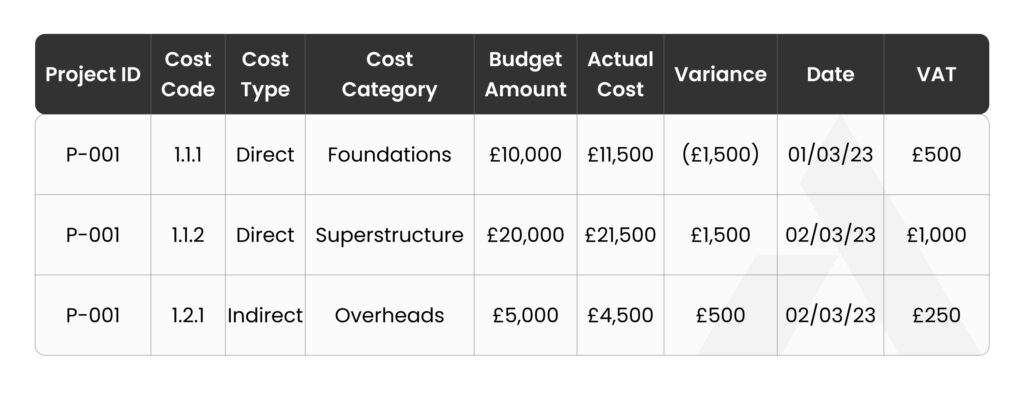
How to structure your cost coding structure
A great tip when building construction code lists is to make your list of project cost codes in the same order you would build a house. This helps keep things organised and logical.
Here's how that translates – if you're using numbers to format your framework, then the earliest stages of the project will appear first on your expense reports. This makes your reports easy to understand and helps with your analysis and decision-making.
Don’t make your categories too specific. There shouldn't be only one thing in each category; it should have a fairly broad range. You can always add later add more levels of detail once you have a framework in place.
A standard construction cost code list could include categories like:
- Excavation
- Permits
- Utilities
- Framing
- Mechanicals
- Plumbing
- Roofing
- Appliances
- Exterior materials
- Interior materials
- Finishings
- …and more
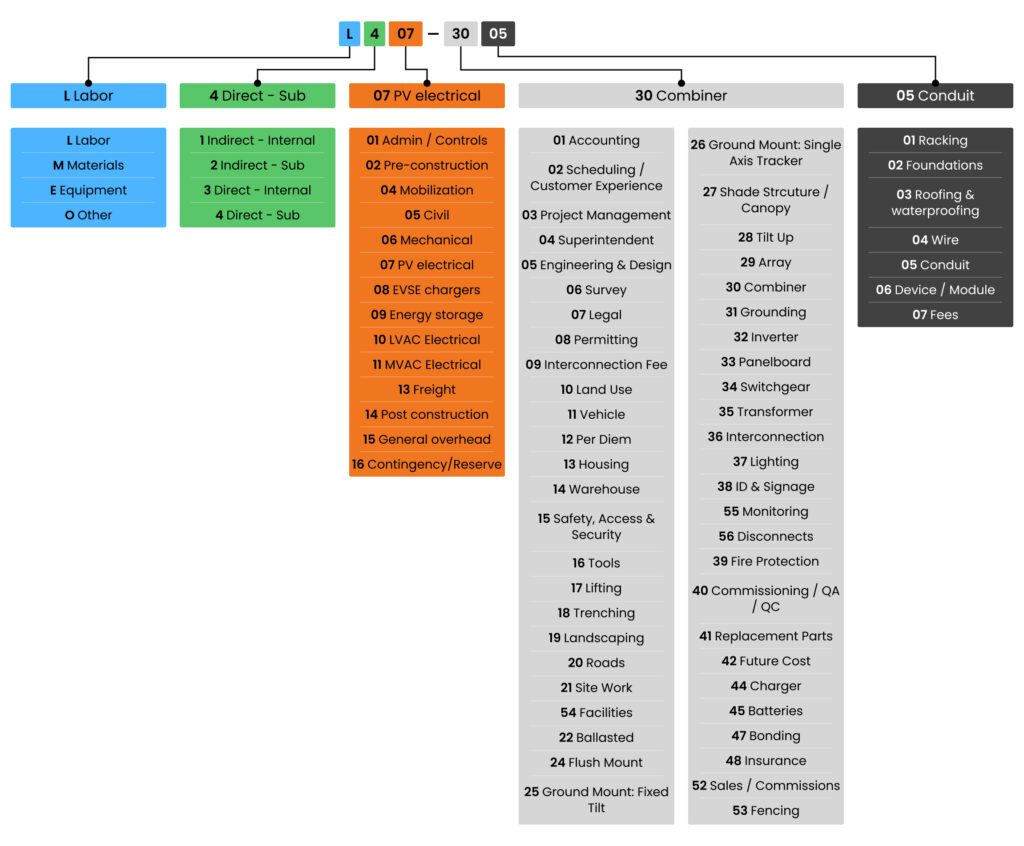
Remember to cover every expense in a project within a category. This includes products, services, labour, and logistics.
Here's an essential guide to construction accounting, for those who aren't accountants.
Why do you need a cost coding structure?
Cost coding structures help standardise the documentation process in a construction project.
They allow construction companies and project managers to categorise costs, understand spending patterns, and provide the documentation necessary for governmental reporting and oversight.
Benefits of a cost coding structure
These are some of the most notable benefits of a cost coding structure.
- Standardisation – allows teams to avoid confusion and costly mistakes from misinterpreted information or data errors.
- Efficient cost management – Using standardised cost codes can streamline cost tracking and allow for better project budget management.
- Real-time cost tracking – Integrating cost codes into your construction project management software lets you keep your project data up-to-date and easily accessible, making reporting and maintenance seamless.
- Profitability – Knowing the cost codes for construction equipment, labour, and materials can help pinpoint areas of a project that are surpassing budget limits or where there is a profit margin.
How a cost coding structure can help budget and cost control
A robust cost coding structure helps you track costs and steer projects before it's too late. In addition to being practical, cost codes are also insightful.
Contractors need help with juggling costs across multiple projects at a time. Using cost codes that follow industry standards allows them to collaborate with other stakeholders easily.
Contractors can then identify which project parts are profitable before investing resources.
Cost codes also allow them to catch spending categories that have gone over budget during a project. This helps to identify bleed points and make adjustments in real-time to avoid further overspending.
For example, a contractor may face the challenge of optimising a task but needs more resources with a significant financial investment. In this situation, subcontracting the work may be a more profitable option.
How a cost coding structure can improve project management & reporting
Construction cost codes are a fantastic technique for standardising data utilised in the sector. A consistent set of codes and numbers allows people in the field to process much information effectively.
Effective cost coding structures facilitate operations by making it simple for businesses to classify, arrange, and track all expenses related to building projects.
They also aid in data analysis and reporting by making it simpler to compare expenses over time for a single project or across other projects.
Additionally, these regulations offer contractors and clients transparency in pricing so everyone can make educated decisions about budgeting and scheduling.
Where can you use a cost coding structure?
Here are a few areas that can use a cost coding structure.
Estimating
Cost code structures allow contractors and project managers to plan future project estimates accurately. They can look at historical data and industry numbers to budget how much different categories will cost in building a particular project.
Job costing on construction accounting software or construction software
Construction accounting software helps you assign specific codes and job costs accurately and quickly.
Suppose you have a cost coding structure in place. In that case, you can feed that information into construction project management software to get a complete picture of all costs associated with a specific job and look at labour, materials and overhead.
Billing
Cost tracking, budgeting, and analysing spending become easy with a cost-coding structure. It also enables cost documentation for all ongoing projects.
You can easily monitor overspending and underspending on a project. With this, your field team can access all project-related information and accounting and billing become effortless.
Do you need to create your own cost coding structure?
Creating your cost codes depends on how you run your projects and business. Most general contractors prefer the standardised construction cost codes because it gives them a broad range to choose from in a project.
Speciality contractors find those categories too general and prefer to create cost code structures. You can create your own cost coding structures depending on your industry or sector.
Occasionally, you’ll be forced to work with non-standard cost coding structures.
When you bid on government or big public contracts like HS2, you may have to work to a mandated cost coding structure. If you don’t have the framework to deal with this, you could lose the bid or come into trouble during the construction projects.
“It was a mess. We had to do the work manually, several times over. Once to match our own cost codes and again to match the contractors. By the time we were done, we didn’t know which way was up.” Danny Mitchell, author and ex-estimator at Sharpfibre, a specialist contractor.
You can overcome this challenge with proper construction management software, like Archdesk, making this process painless. Keep in mind that not all construction software has this capability.
Implement a strategy and process for cost coding
Cost coding is a complex process; however, you can get the most out of it with the right strategy and approach.
Here are a few things to remember when implementing a cost-coding strategy and process.
- Start with Standard Accounting Practices – Before developing construction cost codes, assess your company's accounting practices and policies.
Many companies use generally accepted accounting standards as a foundation for their finances and reporting. Your cost code system must adhere to these guidelines when monitoring project expenses. - Decide what you want to track – Identify which financial data categories are essential for monitoring and reporting. These may include expenditures like labour, equipment, materials, and subcontractor fees.
Knowing which data sets are most relevant to the business can help you organise this information. - Create unique codes for each item/task – Create distinct number codes for each item or task related to the job, such as "materials utilised" or "labour hours expended,".
To obtain more specific information, break down each subcategory further if a category has numerous subcategories (for instance, "materials utilised" may contain concrete and steel). - Integrate with accounting software – Consider linking your building cost code list with accounting software to ensure accuracy in tracking spending across various projects.
By centralising data from different projects, project managers can assess the overall financial performance of several projects at once. - Automate reporting – Managers can access automated reports by combining their building cost code list with accounting software. This allows them to see possible anomalies or errors before they grow into bigger ones.
Tips for using cost coding structures effectively
Here are tips for getting the most from cost coding structures:
-
Ensure consistency in construction cost codes
When building a cost code structure, the most crucial factor to be mindful of is to assign them consistently and accurately.
Make sure the code you assign appropriately describes the activity it refers to. It will cause confusion and illegible reports if you give two distinct goods the same cost code.
Everyone working on the project must understand how codes work because doing so might help to avoid mistakes that could later cost money. Each stage of your project will be more accurate if you assign different, detailed pricing codes.
-
How to use a cost coding structure in project management
Define your construction cost code structure early in the project life cycle. Doing so will enable alignment with the engineering work packages, the construction estimate, the master schedule and the job cost system.
Using an efficient cost coding structure will allow a project manager to organise and better plan big projects by breaking down large jobs into multiple smaller groupings and tasks.
For example, a cost coding structure will allow your project manager to coordinate engineering, equipment, material and labour costs within a project to align with the master schedule.
-
Best practices for updating and maintaining a cost coding structure
Whether using a standardised cost coding structure or creating your own from scratch, here are a few things to remember when updating and maintaining your cost coding structure.
- Keep it simple – For example, if you're running a smaller operation and want to keep things simple, you can assign a code to a subcontractor, such as "plumbing," and then apply that one code to all of the plumbing work on a particular project such as water and wastewater management.
- Consider who will be using the code – For example, different teams and stakeholders will want different levels of detail, so you should provide your team with as much information as they need to feel confident making decisions.
- Use construction management software - Investing in construction management software is a great way to speed up your cost-tracking procedures. Having remote and immediate access to your construction cost codes list will save you time and money whether you generate your own codes or use what the software provides.
Get in touch with us if you want to talk about construction finances
We hope you got what you came for from this article. We've covered the cost code subject in a 'medium' level fashion, but it goes far deeper. If you want more information, or to talk about anything construction, We're always available.
You might also like
February 29, 2024 • 7 min read
Utilizing the human-first approach to construction projects to drive higher results.
July 3, 2023 • 6 min read
8 Best Construction Drawing Management Software (2023): A Comprehensive Guide
Find all the information you need about the construction drawing management software tools available on ...June 14, 2023 • 6 min read
The 11 Best PlanGrid Alternatives (2023)
Looking for a great alternative to PlanGrid software? Check out the 11 best construction software tools ...June 14, 2023 • 4 min read
How to win at CIS 340 and make taxes a breeze
CIS 340 is a legal obligation for contractors. But getting it right isn’t straightforward. Want ...


